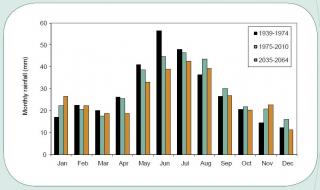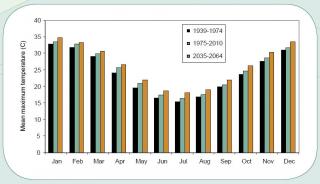Why this information is important
Climate change and climate variability have affected Western Australian (WA) broadacre crop and animal production over recent decades, with significant reductions in rainfall and increased frost risk. Producers have been able to meet these challenges by adopting innovative farming systems to maintain farm profitability and sustainability. Future climate change will present further opportunities and challenges for producers.
Records shows that rainfall decreased and temperatures increased over the last century. Projections for the south west of WA indicate further rainfall declines and higher temperatures.
The grainbelt of WA contributes more than $4.5 billion to WA’s economy per year. Hyden is located 340 kilometres east of Perth on the eastern edge of the central grainbelt. This agri-climate profile provides an analysis of records and projections for a range of climate variables relevant to farm businesses in the Hyden area.
Changes at a glance
The observed trends in Hyden’s climate include:
- increased maximum temperatures
- increased number of days with extreme temperatures
- increased number of frost days in June and October
- reduced growing season rainfall, and
- more-variable and later starts to the growing season.
What the records show
Shifts in climate were observed for Hyden in the mid-1970s, then again around 2000. Therefore, the analyses are for the periods 1931–1974 (43 years), 1975–2018 (43 years) and 2000–2018 (18 years).
Rainfall
- Total annual rainfall has remained relatively unchanged from 1931–1974 to 1975–2018.
- Growing season rainfall (April–October) declined by 2% from 1931–1974 to 1975–2018, with a further 8% decline in the period from 2000–2018.
- The chance of two consecutive drought years (decile 3 growing season rainfall or below) has decreased from 8% in 1931–1974 to 5% in 1975–2018.
June rainfall is significantly reduced in 1975–2018 and 2000-2018.
There has been no significant change in the number of large rainfalls (greater than 5mm) and the number of rain days, apart from in June. The difference between periods in these figures is less important than the variability between years.
Temperature
Since the mid-1970s, mean monthly maximum temperatures have significantly increased for all months except September and December.
Minimum temperatures have significantly increased in February and November.
The number of days with extreme temperatures, or maximum temperature above 35 degrees Celsius (˚C), has significantly increased in the periods from January to April and October to December.
The number of frost days, or days with minimum temperature below 2˚C, has significantly increased in June and October. This indicates that the frost risk around flowering has increased. The average date of the last frost was 7 October in 1931–1974 and 15 October in 1975–2018.
Projected changes
The following projections are for the period 2035–2064. Projections were obtained using an intermediate-emissions scenario (A2) and downscaled data from the CSIRO Global Climate Model CCAM (CMIP3).
Rainfall
Projections are for decreased autumn–winter rainfall and increased summer rainfall.

Temperature
Projections are for increasing average monthly maximum temperatures.

What are the agronomic implications?
- The start of the growing season has generally remained unchanged.
- Later and more variable breaks of season will increase production risk for crops and pastures. Declining autumn rainfall means crops needs to be established at the earliest opportunity. Conservation of out-of-season rain is gaining importance. Effective control of summer weeds and stubble is becoming more important.
- Killing summer weeds can increase the amount of water available in the soil for the growing season. Kill summer weeds as quickly and effectively as possible after they emerge. The first paddocks to treat are those that have the most water and nitrogen to lose (for example, pulse stubbles, long fallow).
- Frost remains a significant risk in winter and spring, and frost risk around flowering has increased significantly. Cold conditions and later starts to the growing season may increase lamb mortality.
What are the options for adapting to climate change?
We provide information and technical support for making changes at the incremental, transitional and transformative levels. A general guide is available for each major enterprise and for soil and water resources:
